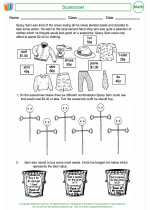Solving for Variables
What is solving for variables?
Solving for variables involves finding the value of a variable in an equation or inequality. In order to solve for a variable, you will need to isolate the variable on one side of the equation or inequality.Steps for solving for variables:
- Use inverse operations: To isolate the variable, use inverse operations to get rid of any constants or coefficients that are attached to the variable.
- Keep equations balanced: Whatever operation you perform on one side of the equation, you must also perform on the other side to keep the equation balanced.
- Simplify: Combine like terms and simplify the equation as much as possible.
- Check your work: Once you have found the value of the variable, substitute it back into the original equation to ensure that it satisfies the equation.
Examples:
Let's consider an example to illustrate the process of solving for a variable:Example 1: Solve for the variable x in the equation 3x + 5 = 11- Subtract 5 from both sides of the equation:3x + 5 - 5 = 11 - 53x = 6
- Divide both sides by 3:3x ÷ 3 = 6 ÷ 3x = 2
- Check your work:3(2) + 5 = 116 + 5 = 1111 = 11
Study Guide:
To effectively solve for variables, it's important to understand the following concepts:- Basic operations (addition, subtraction, multiplication, division)
- Properties of equality
- Understanding and solving equations and inequalities
- Order of operations
◂Math Worksheets and Study Guides Fourth Grade. Money
Study Guide Money
Money  Activity Lesson
Activity Lesson How Much Change?
How Much Change?  Activity Lesson
Activity Lesson Garage Sale
Garage Sale  Activity Lesson
Activity Lesson Scarecrow!
Scarecrow!  Worksheet/Answer key
Worksheet/Answer key Money
Money  Worksheet/Answer key
Worksheet/Answer key Money
Money  Worksheet/Answer key
Worksheet/Answer key Money
Money  Worksheet/Answer key
Worksheet/Answer key Money
Money  Worksheet/Answer key
Worksheet/Answer key Money
Money  Worksheet/Answer key
Worksheet/Answer key Money
Money  Worksheet/Answer key
Worksheet/Answer key Money
Money 

 Activity Lesson
Activity Lesson
 Activity Lesson
Activity Lesson
 Activity Lesson
Activity Lesson
 Worksheet/Answer key
Worksheet/Answer key
 Worksheet/Answer key
Worksheet/Answer key
 Worksheet/Answer key
Worksheet/Answer key
 Worksheet/Answer key
Worksheet/Answer key
 Worksheet/Answer key
Worksheet/Answer key
 Worksheet/Answer key
Worksheet/Answer key
 Worksheet/Answer key
Worksheet/Answer key

Create And Print more Money worksheets with Money Skills Worksheets generator
The resources above cover the following skills:
Algebra (NCTM)
Use mathematical models to represent and understand quantitative relationships.
Model problem situations with objects and use representations such as graphs, tables, and equations to draw conclusions.